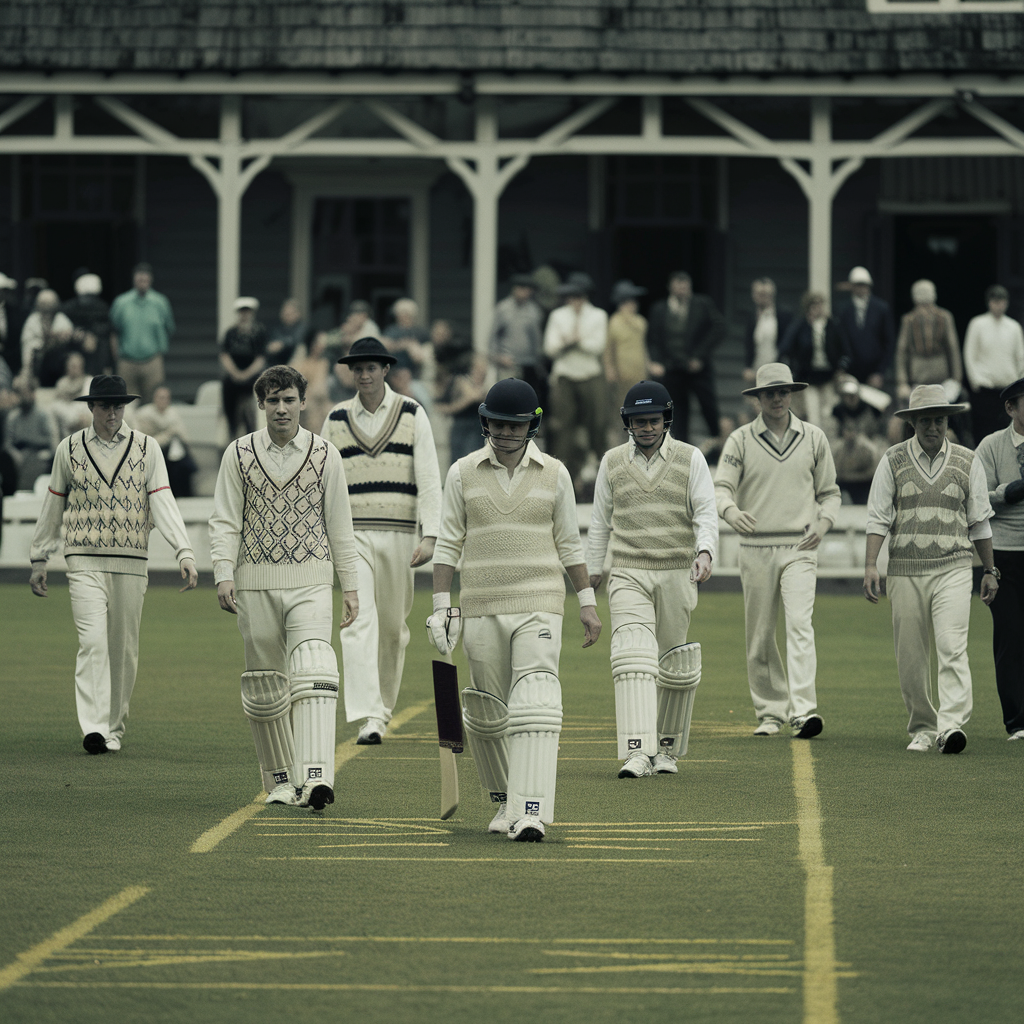The Great Journey: A Comprehensive History of Cricket.”
The Great Journey: A Complete History of Cricket

Introduction:
Cricket, a sport beloved by millions around the world, has a rich and interesting past. In this essay, we shall travel through time to study cricket’s origins, evolution, and global significance. This extensive analysis seeks to provide insight into the sport’s evolution and impact on numerous nations. So tighten the belts and join us on an exciting travel into the world of cricket!
The origins of cricket
Cricket’s history may be traced back to ancient England’s rural fields, when similar games were played. It evolved from a simple hobby into a structured sport, gaining popularity among the English wealthy.
16th Century: Origins in England.
Cricket seems to have started in the 16th century as a primitive game in English villages, developing from earlier sports such as stoolball and club-ball. The first documented reference is from 1598, during a court case involving a cricket match in Guildford, England.
17th Century: Development and Formalization
Cricket gained traction in the 17th century, with the first match played under established rules reported in 1646. As the game became more structured, it became a popular entertainment among the English aristocracy, establishing its status in society.
18th Century: Expansion and Development
The 18th century was essential in cricket’s development. The Hambledon Club, founded in the 1760s, became a hotspot for cricket fans and played an important role in organizing the game. Cricket’s popularity exploded, drawing greater crowds and reaching the busy town of London.
19th Century: Country Cricket and the Major Cricket Club
The nineteenth century saw the formal establishment of county cricket, with regional teams competing. The London Cricket Club (MCC), founded in 1787, played a key role in formalizing cricket rules. Innovations such as round-arm and overarm bowling styles added new dynamics to the game.
1864: The First International Cricket Team.
In 1868, the first international cricket team made up of Aboriginal Australians toured England. This historic event marked the beginning of international cricket, laying the groundwork for future Test matches between nations.
1877: The Origins of Test Cricket
In 1877, England and Australia played their first Test match at the Cricket Ground in Melbourne. This historic match provided the groundwork for Test cricket, with more countries gradually joining the ranks of Test-playing nations.
20th Century: Evolution and Globalization.
The 20th century saw remarkable expansion in cricket. The sport expanded into new territories, with the West Indies, India, Pakistan, and others gaining Test status. The introduction of One Day Internationals (ODIs) and, later, Twenty20 (T20) cricket resulted in faster-paced, spectator-friendly forms that transformed the game.
T20 Growth and Global Tournaments for the 21st Century
Cricket has become more worldwide in the twenty-first century, thanks to the arrival of T20 competitions such as the Indian Premier League. Major international tournaments, such as the Cricket World Cup and the ICC World Twenty20, have become staple of the global sporting calendar.
Cricket has risen from its humble beginnings to become one of the world’s most popular and completely followed sports. Its rich history continues to change, with new stories being created by players on the field as well as spectators and administrators off it, ensuring that cricket’s legacy lives on.
Modern Cricket (1970s–1990s)

The introduction of one-day internationals (ODIs)
The arrival of One-Day Internationals (ODIs) in the early 1970s marked a historic event in the cricketing world. Unlike traditional Test matches, which lasted five days, ODIs were played in a single day, making the game more dynamic and spectator-friendly. The first One-Day International match between Australia and England was played in 1971, starting in a new era of cricket.
The Impact of Limited Overs Cricket
Limited-overs cricket transformed the sport, providing a faster-paced and exciting alternative to traditional Test matches. This format attracted a larger audience, including some who found Test cricket’s long duration lifeless. The excitement and surprise of ODIs kept fans on the edge of their seats, inspiring a newfound love for cricket around the world.
Rise in commercial and media coverage.
With the introduction of ODIs, cricket became growing marketed. Sponsorships, sponsorships, and television rights increased, transforming cricket into a profitable business. The game received expanded media coverage, with broadcasts live reaching millions of households. This period also saw the rise of cricketing superstars who became household names, adding to the sport’s appeal.
The Rise of Twenty20 Cricket
Origins and Early Reception.
In the early 2000s, another new format emerged: Twenty20 (T20) cricket. This format, with just 20 overs a side, was created to be even shorter and more exciting than ODIs. Despite initial doubt, T20 quickly won over fans with its high-energy bouts and outstanding performances.
Influence on the game’s popularity.
T20 cricket boosted the game’s appeal, particularly among younger people. The format’s shortness and entertainment value made it suitable for contemporary lifestyles, attracting new fans and restoring interest in cricket. It also cleared the door for several domestic T20 leagues, which grew into hotbeds for both budding talent and foreign stars.
Key Tournaments and Leagues
Key competitions such as the ICC T20 World Cup, as well as regional leagues like the Indian Premier League (IPL), have grown in popularity. The IPL, in particular, has transformed cricket with its glossy presentation, star-studded teams, and high financial stakes. These competitions not only produced exciting cricketing action, but they also considerably increased the sport’s global profile.
Structure of Modern Cricket
Test cricket is the pinnacle of the sport.
Despite the rise of limited-overs formats, Test cricket is still the summit of the game, representing the ultimate test of skill, endurance, and strategy. Test matches, with their rich history and tradition, are still respected by both fans and players today.
One-Day Internationals: Balancing Traditions with Modernity
The ODI format finds a compromise between the tradition of Test cricket and the modernism of T20s. They provide a balance of planning depth and fast-paced action, making them popular with fans who appreciate both the technical parts of the game and the excitement of a limited-overs match.
Twenty20: Changing the Game.
T20 cricket has transformed the sport by bringing new methods, approaches, and a more aggressive style of play. The format promoted creativity, with players always pushing limits to delight the audience and gain quick victory.
Laws and Culture of Cricket
The Royal Cricket Club (MCC) maintains the cricket laws, which serve as the game’s structure. Along with these principles, the spirit of cricket promotes fair play, respect, and cooperation, ensuring that cricket remains a gentleman’s game.
Major Cricketing Nations
England: the birthplace of cricket.
England, the birthplace of cricket, has a rich cricketing tradition. The country’s historic places, such as Lord’s, and important moments in cricket history place it in the center of the sport’s progress.
India: Cricket’s Financial Powerhouse.
India has emerged as cricket’s financial superpower, due to its huge fan base and profitable domestic competition, the IPL. Indian cricketers are revered as superstars, and the country’s passion for the game is outstanding.
Iconic cricket matches.
The first Test Match (1877)
The first Test match, between Australia and England in 1877, established the basis for international cricket. This historic interaction is celebrated as the beginning of a tradition that has last over a century.
The Bodyline Series (1932-1933)
The Bodyline Series between England and Australia remains one of the most contested in cricket history. England’s aggressive bowling methods prompted a diplomatic dispute while also highlighting the two countries’ strong rivalry.
The Second Test (1960).
The 1960 Tied Test between Australia and the West Indies was an exciting match that ended with both teams tied for runs. This unique result highlighted the unpredictable and exciting aspect of Test cricket.
Cricket’s cultural impact
Cricket in Literature and Film.
Cricket has had a huge impact on literature and movies, generating innumerable works that highlight the sport’s drama and cultural relevance. Cricket stories, from novels to films, captivate people all around the world.
The role of cricket in national identity
Cricket plays an important role in shaping national identities, particularly in India, Pakistan, and Australia. The sport brings people together, instills national pride, and stands as a powerful emblem of heritage and culture.
Cricket as a unifying force.
Cricket has a unique power to bring people together across social and cultural boundaries. Iconic occasions, such as World Cup victories, instill a sense of collective delight and unity in followers.
Cricket & Technology
Advances in Equipment and Gear
Technological developments have greatly improved cricket equipment and gear. Modern bats, protective gear, and apparel improve player performance and safety, furthering the game’s progression.
Application of Technology in Umpiring
Cricket umpiring has likewise undergone a technological revolution. Tools such as the Decision Review System (DRS), Hawk-Eye, and Snickometer promote fairness and prevent conflicts, so improving the game’s integrity.
The Role of Data Analysis
Data analytics have become an essential component of modern cricket. Teams employ advanced analytics to evaluate player performance, devise plans, and gain a competitive advantage. This analytical approach has fundamentally altered how the game is played and controlled.
Women’s Cricket

Early Years and Development.
Women’s cricket has a rich history, dating back to the late nineteenth century. Despite initial difficulties, the sport eventually acquired recognition and support, paving the path for organized championships and international matches.
Rise in Women’s International Cricket
Women’s international cricket has grown significantly, with more countries participating and competing at the top levels. Tournaments such as the Women’s World Cup have highlighted the talent and passion of female cricketers.
Key Players and Milestones
Key players such as Belinda Clark, Mithali Raj, and Ellyse Perry have made an unforgettable influence on women’s cricket. Milestones like the first Women’s T20 World Cup and record-breaking performances have raised the sport’s reputation.
Cricket’s Challenges
Match Fixing and Corruption
Match-fixing and corruption have presented serious threats to cricket’s integrity. Scandals have plagued the sport, forcing strict measures and reforms to protect fair play and public trust.
Balancing traditional and modern formats.
Balancing the classic formats of Test and ODI cricket with the contemporary T20 format is a constant problem. Ensuring that all forms of the game survive necessitates prudent management and creative thinking.
Ensure Financial Sustainability
Ensuring cricket’s financial viability is critical, especially in this era of increased commercialization. Balancing profitability with the sport’s underlying ideals and grassroots development is critical to long-term success.
The Future of Cricket
Development of T20 and Franchise Leagues
The popularity of T20 and franchise leagues shows no signs of waning. These competitions offer exciting chances for both players and fans, accelerating cricket’s worldwide expansion and attracting new audiences.
Expanding the game globally.
Cricket’s global expansion is a significant future focus. Efforts to expand the sport into new regions and encourage rising cricketing nations will help cricket become a truly global game.
Innovation and Potential Changes
Cricket’s future will be shaped by innovations and prospective alterations, such as new formats, enhanced technologies, and changed laws. Accepting these adjustments while retaining the sport’s spirit will be critical.
